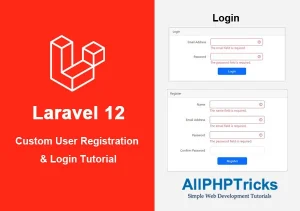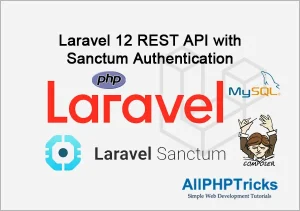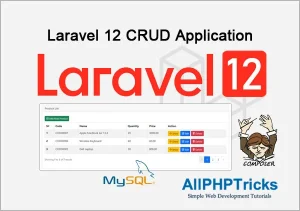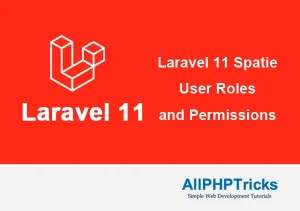Laravel 12 Custom User Registration and Login Tutorial

In this tutorial, I will show you how to create a custom user registration and login system in Laravel 12.
Every Laravel version comes with starter kits – and Laravel 12 includes React, Vue, and Livewire starter kits.
These starter kits provide a built-in user authentication system, including features like registration, login, dashboard, logout, and password reset.
However, in some cases, you may need a custom authentication system tailored to your specific needs.
In this guide, we will learn how to build a custom user login and registration system in a Laravel 12 application.
Steps to Create Custom User Registration and Login in Laravel 12
- Install and Set Up Laravel 12 App
- Define Custom Registration, Login, Home and Logout Routes
- Create a LoginRegister Controller
- Create Login, Registration, Home and App Layout Blade View Files
Step 1: Install and Set Up Laravel 12 App
If you don’t have Laravel 12 installed, first install the Laravel 12 application named CustomLoginRegister using the following command:
composer create-project --prefer-dist laravel/laravel CustomLoginRegisterNow, navigate to the CustomLoginRegister directory using the following command
cd CustomLoginRegisterBy default, Laravel 12 uses SQLite. However, in this tutorial, we will use MySQL.
First, create a database named custom_login_register, then configure your database credentials in the .env file as shown below:
DB_CONNECTION=mysql
DB_HOST=127.0.0.1
DB_PORT=3306
DB_DATABASE=custom_login_register
DB_USERNAME=your_db_username
DB_PASSWORD=your_db_passwordAfter that, migrate all the default tables to the database using the following Artisan command:
php artisan migrateNote: Laravel 12 comes with a users table by default, so we don’t need to create a separate migration or model for it.
Step 2: Define Custom Registration, Login, Home and Logout Routes
Now, we need to create our custom routes for login, registration, home, and logout. Simply open your routes/web.php file and update it with the following code:
<?php
use Illuminate\Support\Facades\Route;
use App\Http\Controllers\Auth\LoginRegisterController;
Route::controller(LoginRegisterController::class)->group(function() {
Route::get('/register', 'register')->name('register');
Route::post('/store', 'store')->name('store');
Route::get('/login', 'login')->name('login');
Route::post('/authenticate', 'authenticate')->name('authenticate');
Route::get('/home', 'home')->name('home');
Route::post('/logout', 'logout')->name('logout');
});Step 3: Create a LoginRegister Controller
In this step, we need to create a new LoginRegisterController using the following Artisan command:
php artisan make:controller Auth\LoginRegisterControllerThis will create a new controller file at:app\Http\Controllers\Auth\LoginRegisterController.php
We will add our GET and POST methods for login, registration, home, logout, and middleware handling in this controller.
Now, update your controller file with the following code:
<?php
namespace App\Http\Controllers\Auth;
use App\Http\Controllers\Controller;
use App\Models\User;
use Illuminate\Http\Request;
use Illuminate\Support\Facades\Auth;
use Illuminate\View\View;
use Illuminate\Http\RedirectResponse;
use Illuminate\Routing\Controllers\HasMiddleware;
use Illuminate\Routing\Controllers\Middleware;
class LoginRegisterController extends Controller implements HasMiddleware
{
public static function middleware(): array
{
return [
new Middleware('guest', except: ['home', 'logout']),
new Middleware('auth', only: ['home', 'logout']),
];
}
public function register(): View
{
return view('auth.register');
}
public function store(Request $request): RedirectResponse
{
$request->validate([
'name' => 'required|string|max:250',
'email' => 'required|string|email:rfc,dns|max:250|unique:users,email',
'password' => 'required|string|min:8|confirmed'
]);
$user = User::create([
'name' => $request->name,
'email' => $request->email,
'password' => $request->password
]);
Auth::login($user);
$request->session()->regenerate();
return redirect()->route('home')
->withSuccess('You have successfully registered & logged in!');
}
public function login(): View
{
return view('auth.login');
}
public function authenticate(Request $request): RedirectResponse
{
$credentials = $request->validate([
'email' => 'required|email',
'password' => 'required'
]);
if(Auth::attempt($credentials))
{
$request->session()->regenerate();
return redirect()->intended('home');
}
return back()->withErrors([
'email' => 'Your provided credentials do not match in our records.',
])->onlyInput('email');
}
public function home(): View
{
return view('auth.home');
}
public function logout(Request $request): RedirectResponse
{
Auth::logout();
$request->session()->invalidate();
$request->session()->regenerateToken();
return redirect()->route('login')
->withSuccess('You have logged out successfully!');
}
}You may have noticed that I am not using Hash::make($request->password) in the store() method. This is because the password field is automatically hashed using attribute casting defined in the User model.
Step 4: Create Login, Registration, Home and App Layout Blade View Files
In this step, we need to create Blade view files for registration, login, home, and the app layout. These are the pages that the user will actually see on the screen.
Run the following Artisan commands to create these view files:
php artisan make:view layouts.app
php artisan make:view auth.register
php artisan make:view auth.login
php artisan make:view auth.homeThe above artisan commands will create the following blade view files:
- app.blade.php
- register.blade.php
- login.blade.php
- home.blade.php
Update the following code in resources/views/layouts/app.blade.php
<!DOCTYPE html>
<html lang="en">
<head>
<meta charset="UTF-8">
<meta name="viewport" content="width=device-width, initial-scale=1.0">
<meta http-equiv="X-UA-Compatible" content="ie=edge">
<title>Laravel 12 Custom User Registration and Login Tutorial - AllPHPTricks.com</title>
<link href="https://cdn.jsdelivr.net/npm/[email protected]/dist/css/bootstrap.min.css" rel="stylesheet" crossorigin="anonymous">
</head>
<body>
<nav class="navbar navbar-expand-lg bg-light">
<div class="container">
<a class="navbar-brand" href="{{ URL('/') }}">Laravel 12 Login Register</a>
<button class="navbar-toggler" type="button" data-bs-toggle="collapse" data-bs-target="#navbarNavDropdown" aria-controls="navbarNavDropdown" aria-expanded="false" aria-label="Toggle navigation">
<span class="navbar-toggler-icon"></span>
</button>
<div class="collapse navbar-collapse" id="navbarNavDropdown">
<ul class="navbar-nav ms-auto">
@guest
<li class="nav-item">
<a class="nav-link {{ (request()->is('login')) ? 'active' : '' }}" href="{{ route('login') }}">Login</a>
</li>
<li class="nav-item">
<a class="nav-link {{ (request()->is('register')) ? 'active' : '' }}" href="{{ route('register') }}">Register</a>
</li>
@else
<li class="nav-item dropdown">
<a class="nav-link dropdown-toggle" href="#" role="button" data-bs-toggle="dropdown" aria-expanded="false">
{{ Auth::user()->name }}
</a>
<ul class="dropdown-menu">
<li><a class="dropdown-item" href="{{ route('logout') }}"
onclick="event.preventDefault();
document.getElementById('logout-form').submit();"
>Logout</a>
<form id="logout-form" action="{{ route('logout') }}" method="POST">
@csrf
</form>
</li>
</ul>
</li>
@endguest
</ul>
</div>
</div>
</nav>
<div class="container">
@yield('content')
<div class="row justify-content-center text-center mt-3">
<div class="col-md-12">
<p>Back to Tutorial:
<a href="https://www.allphptricks.com/laravel-12-custom-user-registration-and-login-tutorial/"><strong>Tutorial Link</strong></a>
</p>
<p>
For More Web Development Tutorials Visit: <a href="https://www.allphptricks.com/"><strong>AllPHPTricks.com</strong></a>
</p>
</div>
</div>
<script src="https://cdn.jsdelivr.net/npm/[email protected]/dist/js/bootstrap.bundle.min.js" crossorigin="anonymous"></script>
</body>
</html>Update the following code in resources/views/auth/register.blade.php
@extends('layouts.app')
@section('content')
<div class="row justify-content-center mt-5">
<div class="col-md-8">
<div class="card">
<div class="card-header">Register</div>
<div class="card-body">
<form action="{{ route('store') }}" method="post">
@csrf
<div class="mb-3 row">
<label for="name" class="col-md-4 col-form-label text-md-end text-start">Name</label>
<div class="col-md-6">
<input type="text" class="form-control @error('name') is-invalid @enderror" id="name" name="name" value="{{ old('name') }}">
@error('name')
<span class="text-danger">{{ $message }}</span>
@enderror
</div>
</div>
<div class="mb-3 row">
<label for="email" class="col-md-4 col-form-label text-md-end text-start">Email Address</label>
<div class="col-md-6">
<input type="email" class="form-control @error('email') is-invalid @enderror" id="email" name="email" value="{{ old('email') }}">
@error('email')
<span class="text-danger">{{ $message }}</span>
@enderror
</div>
</div>
<div class="mb-3 row">
<label for="password" class="col-md-4 col-form-label text-md-end text-start">Password</label>
<div class="col-md-6">
<input type="password" class="form-control @error('password') is-invalid @enderror" id="password" name="password">
@error('password')
<span class="text-danger">{{ $message }}</span>
@enderror
</div>
</div>
<div class="mb-3 row">
<label for="password_confirmation" class="col-md-4 col-form-label text-md-end text-start">Confirm Password</label>
<div class="col-md-6">
<input type="password" class="form-control" id="password_confirmation" name="password_confirmation">
</div>
</div>
<div class="mb-3 row">
<input type="submit" class="col-md-3 offset-md-5 btn btn-primary" value="Register">
</div>
</form>
</div>
</div>
</div>
</div>
@endsectionUpdate the following code in resources/views/auth/login.blade.php
@extends('layouts.app')
@section('content')
<div class="row justify-content-center mt-5">
<div class="col-md-8">
<div class="card">
<div class="card-header">Login</div>
<div class="card-body">
@if ($message = Session::get('success'))
<div class="alert alert-danger text-center">
{{ $message }}
</div>
@endif
<form action="{{ route('authenticate') }}" method="post">
@csrf
<div class="mb-3 row">
<label for="email" class="col-md-4 col-form-label text-md-end text-start">Email Address</label>
<div class="col-md-6">
<input type="email" class="form-control @error('email') is-invalid @enderror" id="email" name="email" value="{{ old('email') }}">
@error('email')
<span class="text-danger">{{ $message }}</span>
@enderror
</div>
</div>
<div class="mb-3 row">
<label for="password" class="col-md-4 col-form-label text-md-end text-start">Password</label>
<div class="col-md-6">
<input type="password" class="form-control @error('password') is-invalid @enderror" id="password" name="password">
@error('password')
<span class="text-danger">{{ $message }}</span>
@enderror
</div>
</div>
<div class="mb-3 row">
<input type="submit" class="col-md-3 offset-md-5 btn btn-primary" value="Login">
</div>
</form>
</div>
</div>
</div>
</div>
@endsectionUpdate the following code in resources/views/auth/home.blade.php
@extends('layouts.app')
@section('content')
<div class="row justify-content-center mt-5">
<div class="col-md-8">
<div class="card">
<div class="card-header">Home</div>
<div class="card-body">
<div class="alert alert-success">
@if ($message = Session::get('success'))
{{ $message }}
@else
You are logged in!
@endif
</div>
</div>
</div>
</div>
</div>
@endsectionCongratulations! You have developed a custom user registration and login system in Laravel 12. Now you can go ahead and test the app by registering a new user and logging in to your application.
Run the following Artisan command to start the Laravel development server:
php artisan serveOpen the following link in web browser.
http://127.0.0.1:8000/registerConclusion:
In this tutorial, we have learned how to create a custom user registration and login system in Laravel 12. This Laravel custom user registration and login system enables more customization and flexibility compared to Laravel’s default authentication systems. If you face any issues during the implementation, feel free to share them in the comments section below.
If you found this tutorial helpful, please share it with your friends and developer groups.
I spent several hours creating this tutorial. If you’d like to say thanks, consider liking my pages on Facebook, Twitter, and GitHub — and don’t forget to share it!
Facebook Official Page: All PHP Tricks
Twitter Official Page: All PHP Tricks



